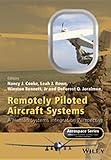Remotely piloted aircraft systems : a human systems integration perspective / [compiled and written by] Nancy J Cooke, Leah J Rowe, Winston Bennett, Jr, DeForest Q Joralmon.
Material type: TextSeries: Aerospace series (Chichester, England)Publisher: Chichester, West Sussex, United Kingdom : John Wiley & Sons, Inc., [2017]Description: 1 online resourceContent type:
TextSeries: Aerospace series (Chichester, England)Publisher: Chichester, West Sussex, United Kingdom : John Wiley & Sons, Inc., [2017]Description: 1 online resourceContent type: - text
- computer
- online resource
- 9781118965887
- 1118965884
- 9781118965894
- 1118965892
- 623.74/69 23
- UG1242.D7
Includes bibliographical references and index.
Description based on print version record and CIP data provided by publisher.
Remotely Piloted Aircraft Systems: A Human Systems Integration Perspective; Table of Contents; Preface; Author Biographies; 1: Human Systems Integration for Remotely Piloted Aircraft Systems; 1.1 What is HSI?; 1.2 Why HSI of RPAS?; 1.3 Terminology; 1.4 The Broad Scope of RPAS; 1.4.1 Air Vehicle Design; 1.4.2 Operation; 1.4.3 Ground Control Systems (GCS); 1.4.4 Crew Requirements; 1.5 Overview of Volume; 1.5.1 Development Process; 1.5.2 Overview of Chapter Content; 1.6 Concept Mapping Exercise; 1.7 Implications of HSI Approach for the future of RPAS; References
2: Evolution of Human Systems Integration for Remotely Piloted Aircraft Systems2.1 Introduction; 2.2 A Brief History of Military RPAS; 2.2.1 Unmanned Aircraft Prior to World War II; 2.2.2 World War II: Aerial Targets and Standoff Weapons; 2.2.3 Targets to Reconnaissance Aircraft; 2.2.4 MQM-105 Aquila: HSI Lessons Learned; 2.3 Competing Programs: National Reconnaissance Office and the Joint Remotely Piloted Vehicle Program; 2.3.1 RQ-4 Global Hawk and the Advent of the Autonomous RPAS; 2.3.2 RQ-5 Hunter: A Poor Start for a New Approach to Acquisition
2.3.3 RQ-7 Shadow: From Strategic Intelligence to Tactical Reconnaissance2.3.4 MQ-1 Predator, MQ-1C Gray Eagle and the Evolution of the Armed RPAS; 2.3.5 RPA Evolution after Predator: MQ-9/Predator B/Reaper, Altair, Ikhana, Mariner; 2.3.6 Progeny of Global Hawk: MQ-4C Triton Broad Area Maritime Surveillance (BAMS) System; 2.4 Contemporary International RPAS Serving Israel and Allied Nations; 2.4.1 Hermes 900 and 450; 2.4.2 Heron and its Many Derivatives; 2.5 Small RPAS; 2.5.1 RQ-11B Raven; 2.5.2 Tarantula Hawk; 2.6 Conclusion; References; 3: Policy Issues of Remotely Piloted Aircraft Systems
3.1 Introduction3.2 The Current State and Issues for RPAS and Policy; 3.2.1 Invasion on Citizens by the Government; 3.2.2 Invasion on Citizens by Citizens; 3.2.3 Invasion on Business by Business; 3.2.4 Invasion on Citizens by Organizations or Business; 3.3 Legal Issues; 3.3.1 The United States Constitution and the Fourth Amendment; 3.4 United States Military and Government; 3.4.1 When Department of Defense Assets and Personnel Can Be Used; 3.4.2 What is Incident Awareness and Assessment and Protection of US Citizen's Privacy; 3.5 An Innovative Approach to Civilian Compliance
3.5.1 Lessons Learned3.6 Case Studies; 3.6.1 Civilian Law Enforcement; 3.6.2 RPAS Use in Monitoring Traffic; 3.6.3 Precision Agriculture; 3.6.4 Environmental Research; 3.6.5 Military; 3.7 Summary and Conclusion; References; 4: Ground Control Systems; 4.1 Scope and Overview; 4.2 Ground Control Systems; 4.2.1 GCS Interface; 4.2.2 Levels of Automation; 4.2.3 Navigation and Terrain Mapping; 4.2.4 Detect and Avoid, Communication, and Lost Link Technologies; 4.2.5 User Interface Trends for Advanced Cockpits; 4.3 Design Lessons Learned; 4.4 Future Design; 4.4.1 Multi-Vehicle/Multi-Domain
Media and Communication
